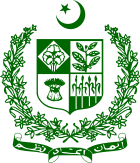- Parliament of Pakistan
-
Parliament of Pakistan
مجلس شوریٰ
Majlis-e-Shoora
Type Type Bicameral Houses Senate
National AssemblyLeadership Chairman of Senate Farooq Naek, (PPP)
since 12th March 2009Speaker of National Assembly Dr. Fehmida Mirza, (PPP)
since 3rd March 2008Structure Members 436 Parliamentarians
100 Senators
336 Member of National AssemblyElections Senate Last election 4 March 2009 National Assembly Last election 18 February 2008 Meeting place 
Parliament House BuildingThe Parliament of Pakistan, officially termed the Majlis-e-Shoora (Urdu: مجلس شوریٰ); is the federal and supreme legislative body of Pakistan. It is a bicameral federal legislature that consists of the Senate and the National Assembly, the upper and lower houses, respectively. According to the constitution, the President of Pakistan is also a component of the Parliament.
The Parliament meets at the Parliament House building in Islamabad, where debating chambers for both houses are present.
Contents
National Assembly
Main article: National Assembly of PakistanThe National Assembly of Pakistan is the lower house of the parliament. The National Assembly has 342 seats, 272 of which are directly elected, 60 are reserved for women and a further 10 for religious minorities.
Senate
Main article: Senate of PakistanThe Senate of Pakistan is the upper house of parliament, with a constitutionally mandated strength of 104 members, of which 17 are reserved for women and 4 for religious minorities. According to the Constitution, the President cannot dissolve the Senate. Members of the Senate are elected by the Provincial Assemblies and serve for a period of six years.
Variant spellings
The Constitution, which is written in English, uses the spelling Majlis-e-Shoora (Parliament).
Majlis-i-Shoora, Majlis-e-Shura, and Majlis-i-Shura are also valid transliterations from the Urdu spelling.
Parliament House Building
The Parliament of Pakistan - viz the Constituent Assembly of Pakistan - met on August 10, 1947 in the old Sindh Assembly Building at Karachi. It was in this venue that the Objectives Resolution, which now serves as the grund norm of Pakistan, was passed. In 1956, the first Constitution of the Islamic Republic of Pakistan was adopted in Karachi at the same Sindh Assembly building which also passed as the Parliament of Pakistan.
After the adoption of the Second Constitution of 1962, Parliament sessions were arranged both at Dhaka and a newly constructed building (Ayub Hall) at Rawalpindi. The Parliament was uni-cameral. At the first session of the Parliament at the Ayub Hall, the Martial Law, imposed in 1958, was revoked. Later, in October, 1966, the Parliament was shifted to Dhaka.
From 1972 onward, the State Bank auditorium in Islamabad functioned as the National Assembly of Pakistan. The Interim Constitution of Pakistan was adopted here in April, 1972. It was here that the first bi-cameral legislature of Pakistan was also born after the Constitution of the Islamic Republic of Pakistan was adopted in 1973. It was again here that the Martial Law, imposed in July, 1977, was revoked on December 30, 1985.
The Parliament - the Senate and the National Assembly - have acquired a permanent abode in the present Parliament House, which was inaugurated on May 28, 1986. The Hall was renovated on the orders of the Speaker and inaugurated by the Prime Minister of Pakistan on 3 November 1996.
Composition
Pakistan 
This article is part of the series:
Politics and government of
PakistanConstitutionParliamentPresidentJudiciaryAdministrative units
2008-present
Seats in the Senate of Pakistan
Party Number Pakistan Peoples Party 27 Pakistan Muslim League (Q) 21 Jamiat Ulema-e-Islam (F) 10 Pakistan Muslim League (N) 7 Muttahida Qaumi Movement 6 Awami National Party 6 FATA 8 Independents 4 Jamaat-e-Islami 3 Balochistan National Party (Awami) 2 National Party 2 Pakistan Muslim League (F) 1 Jamhoori Watan Party 1 Pakistan Peoples Party (Sherpao) 1 Pakhtun-khwa Milli Awami Party 1 Total 100 Seats in the National Assembly of Pakistan
Parties Votes % Elected seats Reserved seats (Women) Reserved seats (Minorities/Non-Muslims) Total Pakistan Peoples Party 10,606,486 30.6% 94 23 4 130 Pakistan Muslim League (N) 6,781,445 19.6% 71 17 3 95 Pakistan Muslim League (Q) 7,989,817 23.0% 42 10 2 55 Muttahida Qaumi Movement 2,507,813 7.4% 19 5 1 26 Awami National Party 700,479 2.0% 10 3 0 13 Muttahida Majlis-e-Amal Pakistan Note: Jamaat-e-Islami Pakistan, Jamiat Ulema-e-Pakistan, Tehrik-e-Jafaria Pakistan and Jamiat Ahle Hadith did not participate.
772,798 2.2% 5 1 0 6 Pakistan Muslim League (F) 4 1 0 5 Pakistan Peoples Party (Sherpao) 140,707 0.4% 1 0 0 1 National Peoples Party 1 0 0 1 Balochistan National Party (Awami) 1 0 0 1 Independents 18 0 0 18 Total 34,665,978 100% 266 60 10 336 Source: Election Commission of Pakistan, Adam Carr's Electoral Archive External links
Parliament of Asia Sovereign
statesAfghanistan · Armenia · Azerbaijan · Bahrain · Bangladesh · Bhutan · Brunei · Burma (Myanmar) · Cambodia · People's Republic of China · Cyprus · East Timor (Timor-Leste) · Egypt · Georgia · India · Indonesia · Iran · Iraq · Israel · Japan · Jordan · Kazakhstan · North Korea · South Korea · Kuwait · Kyrgyzstan · Laos · Lebanon · Malaysia · Maldives · Mongolia · Nepal · Oman · Pakistan · Philippines · Qatar · Russia · Saudi Arabia · Singapore · Sri Lanka · Syria · Tajikistan · Thailand · Turkey · Turkmenistan · United Arab Emirates · Uzbekistan · Vietnam · Yemen
States with limited
recognitionAbkhazia · Nagorno-Karabakh · Northern Cyprus · Palestine · Republic of China (Taiwan) · South Ossetia
Dependencies and
other territoriesChristmas Island · Cocos (Keeling) Islands · Hong Kong · Macau
Categories:- 1953 establishments
- Buildings and structures in Islamabad
- Parliament of Pakistan
- Bicameral legislatures
Wikimedia Foundation. 2010.

